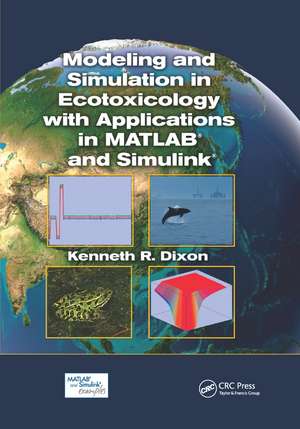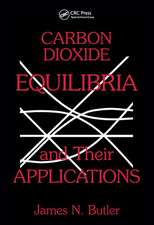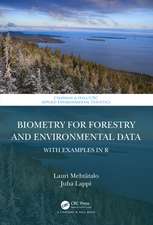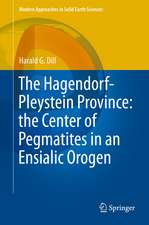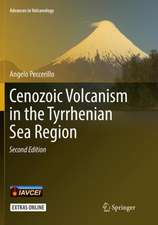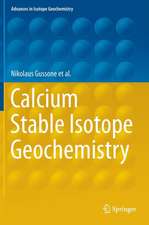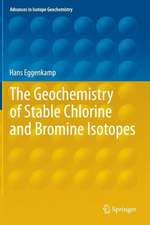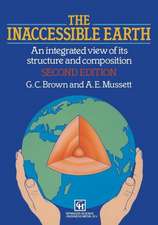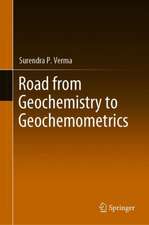Modeling and Simulation in Ecotoxicology with Applications in MATLAB and Simulink
Autor Kenneth R. Dixonen Limba Engleză Paperback – 8 noi 2018
Designed for students and professionals with little or no experience in modeling, the book includes:
- General principles of modeling and simulation and an introduction to MATLAB and Simulink
- Stochastic modeling where variability and uncertainty are acknowledged by making parameters random variables
- Toxicological processes from the level of the individual organism, with worked examples of process models in either MATLAB or Simulink
- Toxicological processes at the level of populations, communities, and ecosystems
- Parameter estimation using least squares regression methods
- The design of simulation experiments similar to the experimental design applied to laboratory or field experiments
- Methods of postsimulation analysis, including stability analysis and sensitivity analysis
- Different levels of model validation and how they are related to the modeling purpose
Presented in a rigorous yet accessible style, the methodology is versatile enough to be readily applicable not only to environmental toxicology but a range of other biological fields.
Preț: 370.25 lei
Preț vechi: 477.21 lei
-22% Nou
Puncte Express: 555
Preț estimativ în valută:
70.86€ • 73.70$ • 58.50£
70.86€ • 73.70$ • 58.50£
Carte tipărită la comandă
Livrare economică 14-28 aprilie
Preluare comenzi: 021 569.72.76
Specificații
ISBN-13: 9781138374485
ISBN-10: 1138374482
Pagini: 272
Ilustrații: 167
Dimensiuni: 178 x 254 mm
Greutate: 0.45 kg
Ediția:1
Editura: CRC Press
Colecția CRC Press
ISBN-10: 1138374482
Pagini: 272
Ilustrații: 167
Dimensiuni: 178 x 254 mm
Greutate: 0.45 kg
Ediția:1
Editura: CRC Press
Colecția CRC Press
Public țintă
Academic and Professional ReferenceCuprins
Introduction. Principles of Modeling and Simulation. Introduction to Matlab and Simulink. Introduction to Stochastic Modeling. Modeling Ecotoxicology of Individuals. Modeling Ecotoxicology of Populations, Communities, and Ecosystems. Parameter Estimation. Designing Simulation Experiments. Analysis of Simulation Experiments. Model Validation. A Model to Predict the Effects of Insecticides on Avian Populations. Case Study: Predicting Health Risk to Bottlenose Dolphins from Exposure to Oil Spill Toxicants. Case Study: Simulating the Effects of Temperature Plumes on the Uptake of Mercury in Daphnia. Index.
Notă biografică
Dr. Kenneth R. Dixon’s current research interests include developing and applying computer simulation models to predict the movement of toxic chemicals in the environment and their effects on human and wildlife populations. He also studies the spatial distribution of toxicants and effects at ecosystem, landscape, and regional scales by integrating models with geographic information systems. Current research projects include developing food-chain models to predict the uptake and effects of pesticides, perchlorate, and explosives; developing spatial models of the spread of infectious diseases; and a mathematical programming model of the effects of pollutants on optimal feeding strategies. Dr. Dixon has taught courses in modeling, geographic information systems, ecosystems analysis, biometry, and wildlife management.
Descriere
Exploring roles critical to environmental toxicology, this volume covers the steps in modeling and simulation from problem conception to validation and simulation analysis. Using the MATLAB and Simulink programming languages, the book presents examples of mathematical functions and simulations, with special emphasis on how to develop mathematical models and run computer simulations of ecotoxicological processes. It also provides three individual case studies. Presented in a rigorous yet accessible style, the methodology is versatile enough to be readily applicable not only to environmental toxicology but a range of other biological fields.
